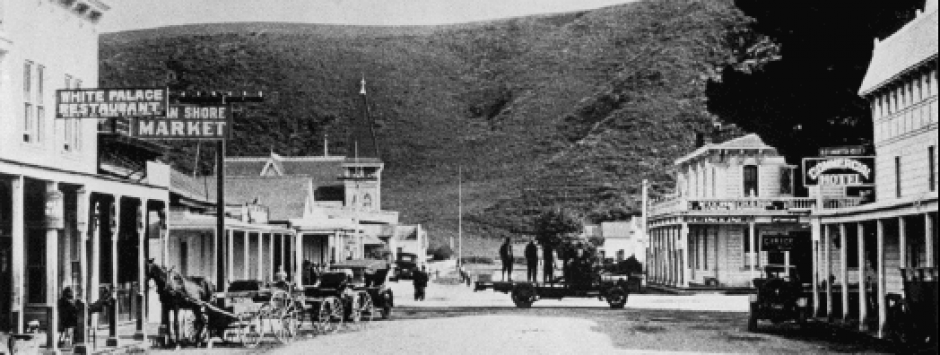Meta
Recent Comments
- Dave Olson on About June Morrall
- Gerd Gunkel on About June Morrall
- Ed Holloway on About June Morrall
Categories
- "Mountain" Mike Merritt (6)
- "The Loop" (1)
- A La California: Sketches of Life in the Golden State (3)
- Acid Beach (5)
- Alexander Moore (1)
- AM Parker (2)
- AMB Beach (3)
- Angelo Misthos (5)
- Ano Nuevo (22)
- Ano Nuevo Island (1)
- Ano Nuevo lighthouse (1)
- Arches (3)
- Ashaleigh Parker (2)
- Atlantis Rising (1)
- Bathhouse Rock (1)
- Beach Clean-Up (2)
- Bean Hollow (2)
- Beat Museum (1)
- Bideawee (1)
- Bob Dougherty (1)
- Bobbi Ballard Pimentel (2)
- Buoys (1)
- Burney J. Le Boeuf (1)
- Burt Blumert (1)
- California Coastal Records Project (1)
- California Newspaper Project (1)
- California State Auto Association (1)
- Carrier Pigeon Point (2)
- Cascade Ranch Dairy (2)
- Charles Clark (1)
- Charles F. Humphrey (1)
- Charles Jones (1)
- Charles Swanton (1)
- Chicken's Roost (1)
- clusters (2)
- Coast Survey Maps (1)
- Coastside Arches (2)
- Coastside Beaches (1)
- Coastside Caves (1)
- Coastside Secret Beaches (5)
- Coastside Waterfalls (1)
- Coburn Mystery (14)
- Coburn Troley Co. (1)
- Colombia (4)
- Colonel Albert S. Evans (4)
- Colonel Zig Zag (1)
- Connie Morgan (1)
- Coya British Bark (1)
- Dan Mosier (1)
- Daniel Boone (1)
- Daniel Durigan (1)
- Dave Cline (1)
- Dave Holleman (1)
- Davenport (2)
- David Gremard Romero (1)
- Downey Harvey (1)
- Dr. Alan Brown (2)
- Dr. Carl Djerassi (1)
- Dr. Isaac Goodspeed (1)
- Dr. W. J. Marsh (1)
- Duarte's Tavern (1)
- Eadweard Muybridge (1)
- Edward Mullen (2)
- Eli D. Moore (2)
- Ezra Pound (1)
- Fireman Collins (1)
- Forget-Me-Not Barkentine (1)
- Fourth of July (1)
- Franklin Point (2)
- Fremont Older (1)
- Friends of the Calamari (1)
- Galen Wolf (1)
- Gary Gates & Friends (1)
- Gazos Creek (6)
- Geocaching (1)
- Ghost Net (1)
- Giant Limpets (1)
- gooseneck barnacles (1)
- Gordon's Chute (3)
- Guadalupe Fur Seal (1)
- Harvey Mowry (3)
- Hellespoint Shipwreck (1)
- Hen Frigates (2)
- Henry Blomquist (1)
- Henry Cowell (1)
- Historic Bottles (1)
- Hole in the Wall (2)
- Holes in Pescadero (1)
- Ida J. Steele (1)
- Invisible Beach (12)
- Isaac Graham (1)
- J. W.Seaver (1)
- Jan "the beeman" Snyder (1)
- Jane Schlager (1)
- Janet Creelman (1)
- Jerry Cimino (1)
- Jim Denevan (1)
- Jo Lysowsky (1)
- Joan Druett (2)
- JoAnn Semones (2)
- Joaquin Miller (1)
- Joel Bratman (2)
- John McCormick (1)
- John Morrall (1)
- John Schamle (1)
- John Vonderlin (171)
- Jon Boxerman (1)
- Josiah P. Ames (1)
- Judge Horace Templeton (1)
- Judge James T. O'Keefe (1)
- June Morrall (6)
- Kathy Duarte (1)
- Ken Fisher (1)
- Ken Kesey (6)
- Kings Mountain (1)
- Kristina Schmale (1)
- La Honda (6)
- Lake Lucerne (1)
- Larry (1)
- Larry Fitterer (8)
- Larry Witham (1)
- Laura Wall Taylor (1)
- Leah Lubin (1)
- Lemuel Coburn (1)
- Levy Brothers (7)
- Linda Wyatt Iacono (1)
- Lizzie McCormick (4)
- Lobitos (2)
- Loma Mar (1)
- Loren Coburn (3)
- Lou Denny Wayne (2)
- Mammoth Rocks (1)
- Manuel Chorro (1)
- Marty McCormick (1)
- Mary Florey (1)
- Merrill Bickford (2)
- Message in a bottle (1)
- Michael Bowen (1)
- Michael Head (1)
- Mike Merritt (2)
- Minot Judson (1)
- Molly Ramolla (1)
- Monty Parker (8)
- Myrtle Garavanta (1)
- Mystic Cowboy (1)
- Neal Cassady (1)
- Neptune's Vomitorium (6)
- Notrocks (1)
- Nunziati Dam (1)
- Ocean Shore Railroad (7)
- Oil (4)
- Omar N. Steele (3)
- Orril Fluharty (4)
- Orrin Brown (1)
- Outstandinginthefield (1)
- Pacific City/Coyote Point (1)
- Pacific Mail Carrier Peru (1)
- Palmer Gulch Trestle (1)
- Pebble Beach Hotel (2)
- Pebble Beach Poetry (1)
- Pescadero (26)
- Pescadero Architecture (3)
- Pescadero Hgh School (1)
- Pescadero Historical Society (2)
- Pescadero Oral History Project (1)
- Pescadero Trivia (1)
- Pescadero's Pebble Beach Hotel (3)
- Pigeon Point (3)
- Pigeon Point Lighthouse (13)
- Place Names of San Mateo County (2)
- Pomponio (2)
- Pomponio Creek (1)
- Princeton-by-the-Sea (1)
- Prohibition (6)
- Purisima Falls (2)
- Purple People Eaters (1)
- Pyramids (2)
- Ralph E. Wall (1)
- Redwood Trees (2)
- Rennesselear Steele (1)
- Richard Ledford (2)
- Rob Tillitz (2)
- Robin Caldwell (3)
- Ron Duarte (2)
- Russell Towle (23)
- Samuel Bean (1)
- San Francisco Call (1)
- San Gregorio (3)
- San Juan (3)
- San Mateo County History Museum (1)
- Sarah Coburn (1)
- Sarah Swanton (1)
- Sawmills (1)
- Sea Monster (1)
- Sea Serpents (1)
- Shawn Mann (1)
- Sheri Martinelli (2)
- Sir John Franklin (1)
- Smuggler's Cove (1)
- Snails (1)
- South Coast beaches (6)
- South Coast Brick (1)
- South Coast Tunnels (4)
- Spaulding Corner (1)
- SS Fremont (1)
- Stacy Trevenon (1)
- Steele Family (6)
- Storm 1998 (1)
- Susan Friedman (3)
- Swanton House (1)
- Tafoni (1)
- Tarballs (1)
- Terry Adams (3)
- Tess Black (3)
- The Butano (7)
- The Contender (4)
- The Gazos (1)
- The Notch (1)
- The Pollocks (1)
- The Quest (3)
- The Seven Sisters (1)
- The Wrack (2)
- Thomas Butwell (1)
- Tires (2)
- Tom Butwell (1)
- Torquay (2)
- Trefiret Beach (1)
- Tunitas Creek (9)
- Uncategorized (412)
- Upenuf Road (1)
- Vanishing Beaches (1)
- Vulcan's Donut (1)
- Wadell Beach Bypass (1)
- Warm Water Lagoon (4)
- Whale Fall (1)
- Whale Watching (1)
- whaling (2)
- William Steele (1)
- Willowside Dairy (2)
- WJ Savage (1)
- Worm Farm (2)
- WWII Coastside (2)
At last. Why “the mount” is called Lincoln
Story from John Vonderlin
Email John ([email protected])
Hi June,
This is Part 3A of Sigma’s 4 part travelogue about Pescadero that appeared in “The Daily Alta,” of San Francisco. It’s quite long, so I split it at the beginning of his description of his trip to Pebble Beach. Enjoy. John
SAN FRANCISCO: Thursday, May 25, 1867. Number Three (FROM AN OCCASIONAL CORRESPONDENT) Pescadero May 31th. 1867. Editors Alta: The country around here presents as great a variety of attractions for the tourist and pleasure-seeker as any part of the coast, and for hunting or fishing no better field can be found for these favorite amusements. The hills around abound in game or all kinds— rabbits, quail, doves, plover, pigeons; and deer are often seen in the hills. If one feels like engaging in a scientific bear hunt, an opportunity for that kind of sport can be had by a. little travel up the mountains. The hunting ground for the smaller game extends from the hills around the valley to the wooded peaks of the Coast Range — up hill, down dale and in the ravines; as far as the eye can reach, almost the hunting ground may be seen, in which the sportsman can indulge to his own liking. As there is, however, a law against shooting the poor harmless quail at this season, one must be content to fall back on other game. For the trout-fisher and angler there is also a wide field of sport in the streams or creeks around the valley — the Pescadero, Butano, Gatos, etc. Those who have returned from such excursions pronounce the two latter preferable; while some parties have explored Scott’s Creek with considerable success, and returned from a camping-out with baskets of delicious trout, and in line spirits from their healthy recreation. There are pleasant drives up-valley and over the flower-carpeted hills, which is another source of amusement, as well as means of health — the roads leading in various directions, to the beach, dairy ranches, through deep gorges and wooded delta, where plenty of spring water can be found; around the hillsides and rocks in search of wild strawberries, or gathering beautiful and fragrant garlands of wild flowers; or up the mountains, where one may spend a day in the.deep, wild woods and stately forests, among the mammoth trees which rear their giant tops, towards Heaven almost, and whose widespreading branches afford a grateful shelter.
MOUNT LINCOLN, Just in front of the hotel, affords a splendid view to those who desire to make the trip. A year or two ago, a gentleman from San Francisco paid to have a flagstaff erected on this noble looking mount, and offered to present an American flag, on condition that it should be named “Mount Lincoln,” all of which was done. and it wasn’t long after the Stars and Stripes could be seen on the eminence, unfurled to the breeze. The last winter’s storms and winds, however, carried away the staff, but the spot is still cherished and will always bear the memorable name. The view from this point is truly grand, and the scenery varied. The peaceful valley below the feet, with its neat white buildings and pleasant gardens, the smooth fields ready for the harvest, and again, fields of waving grain; the long line of hills — ” Like Alps on Alps arise,” with their bold outlines, heights, and depths, surround the valley, rich in their green verdure, producing a splendid effect on the mist just rising from their tops, from the rays of the morning sun; the roar of the surf on the ocean beach fills the ear with a strange noise, while the mind is absorbed in contemplations of the scene around. Under the feet and all around, in every direction, are myraids of wild flowers of every color and hue, the sweeetness of their perfume filling the air. WILD FLOWERS Upon the hillsides and valleys great and mysterious truths are written by flowers, for they are truly called the “alphabet of the angels.” It is a beautiful thought, and well confirmed by Fanny Forrester, who said that alone in the depth of the forests the scent of the wild flowers made her feel safe. for flowers always betray the presence of angels. And here, on Mount Lincoln, one, indeed, may see them in all their glory; aye, the mountain sides, down the hills, in the ravines, across the plains, even to the sandhills, and near the ocean beach is an inviting spectacle of emerald splendor — a luxuriance of flowers, or carpets of the greenest verdure, I -ruling a perfect landscape of Nature’s loveliness. The botanist could spend a pleasant time roaming through these regions in search of the Flora, many of which are very peculiar. Flowers, here, there, everywhere, seeming like fond hopes, gilded with glorious tints of happiness and joy: but soon the sweetness of their perfume will fade, their beautiful leaves will be withered and scattered, and like many noble hearts we have met in the journey of life, near and dear to us, they will be gone from our gaze forever, and nothing left as their requiem but the winds, to make wild music over their graves. The weather has been somewhat changeable of late in thePescadero Valley. The fog shrouds the hills early in the morning, and hangs over the valley, almost hiding the rays of the sun for hours; but nature has ordered wisely, for they are the magic wand that gives life to the hills and clothes them in green, affording rich nutriment for the dairy stock. The fogs are indeed the life of the country here, rendering everything green and vernal from the valleys to the hills, and even to the noble oaks and forest trees of the mountain sides, whose drapery of mosses and beautiful parasites are fostered by their reviving influence The days are pleasant, and the rays of the sun comfortable and of a genial warmth. Some of the evenings have been quite cool, and one has been fain to creep into the family circle at nightfall, around a cheerful and blazing wool fire, and chat the evening away. Such is a brief retrospect of life in the valley; and leaving the subject for the present, we will now take a few pleasure trips to those resorts spoken of in my last, commencing with: PEBBLE BEACH
Posted in Uncategorized
Comments Off on At last. Why “the mount” is called Lincoln
John Vonderlin Asks: Want to know more about the eccentric Cowells?
Story by John Vonderlin
Email John ([email protected])
The following website gives a good history of the Cowells, a rather unusual family. www.santacruzpl.org/history/people/cowella.shtml Irrespective of the “love child” incident, they seemed to have been a very private family with strong philanthropic instincts. Enjoy. John
Posted in Uncategorized
Comments Off on John Vonderlin Asks: Want to know more about the eccentric Cowells?
John Vonderlin: A Visit to Pescadero Valley on May 15, 1867
Story from John Vonderlin
Email John ([email protected])
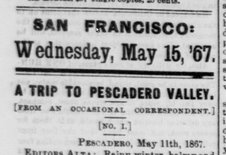

Hi June,
The OCR version of this story is poor quality, but if you want to post this series (I think I sent you ScreenShots of the other parts) let me know and I’ll do the corrections necessary. Finding this article was not easy as its title was not the same as the latter parts and the Search system leaves a lot to be desired. I just lucked out. I had delusions for a while that Sigma was Mark Twain, but don’t believe so now. Still, I like the guy’s writing style and there is virtually nothing like this from so early in Coastside history. . Enjoy. John—
A VISIT TO PESCADERO VALLEY
SAN FRANCISCO: Wednesday, May 15, ’67. (From An Occasional Correspondent). NO. 1. Pescadero May 11, 1867 Editors Alta: Rainy winter, balmy and beautiful spring, have passed, and the dry, disagreeable winds of summer, with their clouds of dust, sweep through the streets of San Francisco. For some months to come the worst season of the year has to be endured by those who are compelled perforce to remain in town; while those who think of going away for the summer months naturally ask themselves: Where shall I go? Now, to my mind, the question is easily answered, as it depends entirely upon the feelings and habits, or custom. To those who know the ropes, as the saying is, I need say little, for there are plenty of resorts in our State for the tourist, naturalist or botanist, the invalid or pleasure-seeker, the quiet or the gay, the lover of fashion, those who desire to live a feather-bed life and loaf luxuriously, or those who crave comfort and recreation in tbe good old-fashioned way. Each has his individual tastes, and it requires no advice what direction to take when so many avenues lie open. From the flower-carpeted hills around San Francisco, the shady nooks ard ravines of Contra Costa, the regions of Napa County and the charms of Calistoga. the magical and life-prolonging waters of the Warm Springs, the rolling surf and seas are luxuries of Santa Cruz, the medicinal waters and fashionable life at Saratoga, the wonders of Nature and magnificent scenery at the Yosemite, or the big trees of Mariposa— [l must not forget Newport, whose fame has already reached the Atlantic shores] — to the quiet country, and some retired spot near the sea shore, where the charms of Nature may be enjoyed by day, and the roar of old ocean, heard, as a lullaby, at night; in short, to where rest and recreation may be enjoyed to their full extent—where we may inhale the pure air from the mountains, drink in the fresh ocean breezes, and enjoy Nature in her most agreeable form; to see, think, study, rest and benefit health, and live free and unshackled from the killing restraints of the society of fashionable watering places. Hearing casually of the great charms and attractive resorts of tbe Pescadero Valley, and it being a region yet unvisited by me. besides possessing many inducements to the tourist, I determined to make the trip and satisfy myself by actual observation. At this part of Santa Cruz County has. been but imperfectly known to the travelling public, and many may desire to know of its many charms, perhaps I may favor your readers with some of my experience, should I deem it of sufficient interest, after a rumble I intend to make through the valley, examining its various resorts and places of interest, dairy farms, agricultural improvements, and look into matters generally, as I am told there is much to see, and seeing will be believing.
How to get there?
This is not only a matter of some importance, but will serve of convenience to all who wish to enjoy magnificent scenery, and a day’s ride from the city to the sea shore: those – ” Who love to steal awhile away From every mortal care,” etc. Take the early morning train from the San Jose depot, and a pleasant hour’s ride lands you at San Mateo, where you will find stages in waiting for Half Moon Bay and Pescadero, which latter place you will reach about 8 o’clock P. M., after a pleasant, though, perhaps, to some, a fatiguing journey of four to five hours. The stages are driven by careful and experienced drivers, among whom there is some rivalry, I learn, as there generally is in most all branches of trade. But havng no particular choice at the time, except to get an outside seat by the driver (on purpose to ask questions) I took tbe first which presented itself, which, as I afterwardi learned, belonged to the San Mateo Stage Company, the reins being handled by the veteran driver. John O. Moore. This line carries the Express of Kennedy & Co., connecting with WeIls, Fargo & Co. Express of San Mateo: and without any intimation to partiality whatever, I must say that it was the mosl expert and careful driving I have seen for many a day, which, from the wild and peculiar character of the mountain roads, requires those requisites to make tbe trip not only pleasant but safe.
Scenery, Etc.
Leaving San Mateo, a drive of five miles, over a pleasant and romantic road, brings the traveller to Crystal Springs. The road is lined on either side, and even extending far back towards the foothills, with dense shrubbery, and varieties of beautiful native trees, sucb at the laurel, oak, sycamore, bay, and groves of tbe beautiful ceanothus, witb its delicate blue flowers; the green turf is covered with patches of wild flowers of every hue and variety, their sweet odor filling tbe air, while tbe warbling of feathered songsters makes, sweet music to tbe ear. Boats. A word or two in regard to the road. It is, like all mountain roads from the city to the sea shore— l may say, like life, it has its ups and downs. Many there are who grumble unceasingly in travelling, because they cannot have all they wish. Such people are “born with a pewter spoon in their mouth;” they want to see the country, but can’t stand a little rough riding, and curse tbeir luck because they are not provided with splendid city equipage, with velvetcushioned seats, on patent springs, ready to glide along smoothly, as if over a macadamized turnpike. Such people, generally, are fools, and they had better stay at home. The ride from San Mateo is a delightful one for over one-half the distance, the only annoyance a little dust, etc.. in some places. Good, comfortable four and six-ho-se Concord coaches and wagons, and the most careful and experienced drivers in the State. If you are only half as good-natured »nd agreeable as they are, who have all the risk, care and fatigue of such a life, you will get along very well, for with a little patience half the trouble ends, and when at your journey’s end, feel doubly repaid at the magnificent scenery you have enjoyed, the cool breezes from the Pacific on the mountain heights, a view of the smiling valley, and the general scenery which meets the eye at every turn ; and last, but not least, know that you are in comfortable quarters at Swanton’s Hotel, with a good home table, plenty to eat, and a desire for a good night’s rest, which you can enjoy all the better if you have an easy conscience.” And here I must close for the present, until I can take a look around the Valley, visiting the different points of interest, for I am told there is much to see, and as I intend to see all I can, I may in my next tell you something about it, but for the present I will take a little rest. I noticed that the Alta, has quite a large circulation all along the road, as well as in this neighborhood, it being the only San Francisco paper I have seen. The driver told me that it was considered by the residents along the road and through the country as quite a home institution. I should think so from the big package distributed. The weather is cool and delightful. Plenty of enjoyment in prospective. The people generally are very pleasant and sociable. Yours truly, Sigma.
Posted in Uncategorized
Comments Off on John Vonderlin: A Visit to Pescadero Valley on May 15, 1867
John Vonderlin: Mystery Redwood Log Bridge
Story from John Vonderlin
Email John ([email protected])

Hi June,
You ever hear of Cerritos Creek Bridge? Enjoy. John
Remarkable Bridge
It Crosses Cerritos Creek Not Far From San Gregorio
One of the most remarkable wooden bridges ever built in California, if not in the United States. Is still standing in a fair state of preservation. It crosses Cerritos Creek on the stage road between San Mateo and Pescadero, a few miles north of San Gregorio.
The most striking thing about the appearance of this bridge is its enormous height. The center span crosses the creek ninety feet above the water.
It is not known who the engineers were that built the bridge, not just what facilities they had for doing the work. The structure was put up about 1858 and has remained in constant use ever since. It is true the stages do not cross it now, but foot passengers and smaller vehicles use it regularly. The only effect of its long years of service is a slight swag at the northern end.
The bridge is really built of the trunks of redwood trees that were hauled from the forests about fifteen miles away. How they were placed in position is something past finding out, as there is nobody living in the locality that remembers when the bridge was put up. And, indeed, it looks as if the job would puzzle an engineer of today, even though he were given the use of all modern appliances, which the others did not have.
In all there are seventy upright supports in the bridge and they must have been stood on end entirely by the use of ropes, pulleys and muscle. Those in the center of the bridge are the highest and the others get shorter and shorter as they climb the bank on either side. Very few braces are used, so that the bridge presents the appearance of a series of straight poles reaching across the ravine. The country in this vicinity is picturesque and wild and the bridge does not look the least bit out of place. In fact it rather blends into the landscape. It does not present a very beautiful appearance nor does it look grotesque.
Posted in Uncategorized
Comments Off on John Vonderlin: Mystery Redwood Log Bridge
John Vonderlin: Where in the world is Bellevale?
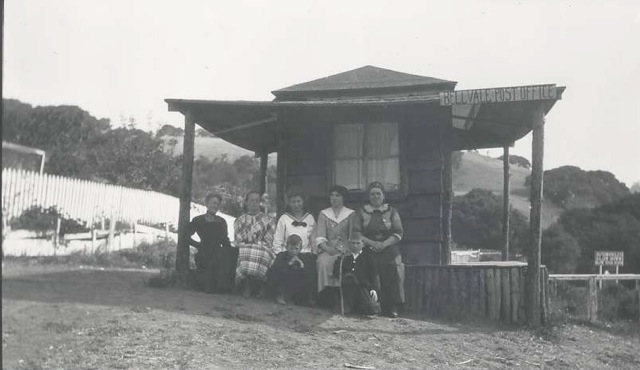
[Image: The Bellevale Post Office. Photo by Moss Beach Postmaster R. Guy Smith]
Story by John Vonderlin
Email John ([email protected])
Hi June,
While looking through old newspapers online I came on an ad that mentioned the stage stopping at La Honda, Hayward’s, Wurr’s, Bellvale and Pigeon Point. Curious about the town of Bellvale, as I had never heard of it before, I did some research. Wikipedia has this short article on it. I’ve attached a ScreenShot of a Q & A column from the October 16th, 1908 issue of the Call] that asks and answers where Bellvale is and a ScreenShot of a bit of Federal Government news about the Post Office from 1904..


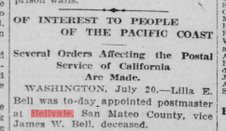
I wonder if Mrs. Bell was the last of the Postmasters for Bellvale, holding the post until it closed in 1922? Do you have any idea about where Hayward’s was? Enjoy. John
Bellvale, California is a populated place in San Mateo County, located at latitude 371843N, longitude 1221912W (decimal degrees: latitude 37.31194, longitude -122.32). The small community is on Highway 84 (La Honda Road) between San Gregorio and La Honda. Bellvale has an elevation of 240 feet above sea level.[1] Although Bellvale once had a post office, the community is now only sparsely settled with homes and farms.[2] The Bellvale post office, located 2.25 miles west of La Honda, opened in 1897 and was discontinued in 1922.[3] U.S. Geological Survey maps show oil wells in the area, tapping a relatively small pool of petroleum that was first identified in the nineteenth century.[4]
Posted in Uncategorized
Comments Off on John Vonderlin: Where in the world is Bellevale?
Jane Schlager: My Great-Great Grandfather, Samuel Bean, built the Presbyterian Church
Dear June,
I was wondering if you have any information on the builder, Samuel Bean. I was told that my family “sailed around the horn”, settling in the Redwood City area in 1849. I was told he built the Presbyterian Church in Pescadero which is now a historical landmark and that Bean Hollow was named form. I still have some of his building records from that time.
Thank you,
Jane E. Schlager,
Burlingame, CA
Hello June,
Samuel Bean is my great great grandfather.
He married Celia White Hankerson (from Maine, 1861)) July 6, 1861 in San Francisco by Starr King.
She was a sponsor of San Mateo County and was a dress maker in Redwood City. (published in the illustrated history of San Mateo County)
I have a copy of a book where he keeps a record of building materials and wages (1873-74).
I also have a copy of his funeral service that was a printed booklet.
My aunt has more information. I was just curious and was “surfing the web” the other evening.
Blessings, Jane
Posted in Jane Schlager, Samuel Bean
Tagged Jane Schlager, Samuel Bean
Comments Off on Jane Schlager: My Great-Great Grandfather, Samuel Bean, built the Presbyterian Church
1896: John Vonderlin’s grateful “Colombia Cove” didn’t stick
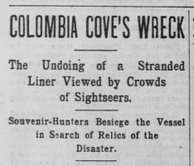

Story by John Vonderlin
Email John ([email protected])
Hi June,
You might want to add this story from the July 19th, 1896 issue of the San Francisco Call to your Colombia shipwreck info collection. I’ve got a few others I’ll send along about the scavenging, sightseeing boat excursions, etc. I’m glad the name Colombia Cove didn’t stick. Enjoy. John.
COLOMBIA COVE’S WRECK
The Undoing of a Stranded
Liner Viewed by Crowds
of Sightseers.
Souvenir-Hunters Besiege the Vessel
in Search of Relics of the
Disaster.
ON BOARD STEAMSHIP COLOMBIA,
ashore off Pigeon Point Light (via Pesca –
dero, Cal.), July 18.―The wrecking of the
steamer goes on, though tbe bay (they
call it Colombia Cove now) is calm and
the breakers stilled. The ship’s people
know that at any time the waves from a
local blow, or a mountainous swell boating
in from some far off gale will drive tbe
crew ashore and finish the work of the
reef.
Everything that can be moved and re –
moved to the schooners alongside is
wrenched and torn from its fastenings and
hoisted over tbe rail with the still useful
donkey-engine.
That donkey-machine has immortalized
itself. While the great main engines of
the ship lie dead and corroding under
water, the donkey-boiler, perched above
the sea, is in action, and Fireman Collins
is the sooty Casablanca who stays by the
furnace.
When the tide registers high on the
liter-marks on the bulkhead and his fire
sizzles out he drops his shovel, washes his
face in the flood that chases him from his
post and goes up the ladder. Though Col –
lins is a king in a small way. he can stay
the sea no more than did Canute ages ago;
but he gets a good head of steam on before
the water laps over the gratebars and the
faithful “donkey” runs until the tide falls.
Then Collins again starts his fire and lor
a season defies the waves.
One of the foremost laborers in the work
of stripping the steamer is Ship-Carpenter
Wheaton. He assisted in building the
Colombia and is now engaged in undoing
his work. With chisel and crowbar he
ruthlessly wrenches mirrors, desks, wash –
stands, racks and lamps from their places
and tosses them out onto the deck to be
hoisted aboard the awaiting schooners.
He removed the piano from the saloon
yesterday, but with more care than he be –
stows on his other plunder. There are
three other pianos down in the flooded
hold.
The only idle person aboard the Colom –
bia is Customs Inspector O’Leary, who is
here to see that nothing dutiable washes
out through the holes in tie hulk without
his chalkmarks thereon. As he has no
diving suit he is unable to get down into
the hold and prevent the landing of the
cargo, and consequently he is in a quan –
dary. He trusts that Deputy Collector
Bam Rudell will understand the situation.
The only foreign importations that have
escaped him thus far are about 40,000,000
limes that have gone bobbing merrily one
by one through the breakers to the beach
without permission lrom the Treasury
Department. Inspector O’Leary has missed
several cases of men’s trousers from the
ship, which have gone out through the
shattered bottom and have disappeared.
The souvenir fiend has come down upon
the helpless ship. Every article worthless
for practical uses has been picked up,
whether floating or beached, and borne
away to be exhibited in after years as a
memento of Colombia Cove’s last victim.
One woman tourist from Boston found on
the beach a sardine can which Joe Levy of
Pescadeo had thrown away after eating its
contents on the bluff the day before.
An old gentleman hailing from Belve –
dere secured a driftinc beer-bottle and
carried it away in triumph, nor recogniz –
ing it as having accompanied him to the
locality that morning. A sweet Stanford
co-ed risked her life snatching from the
salt sea waves a pocket-comb which her
escort, a football savage, had lost. He
had been combing his long, Samsonian
tresses behind a rock a la mermaid and
had dropped it overboard.
The country swarms with midsummer
campers and the shipwreck is an addi –
tional attraction for them. They come
down tbe beach, sit on the rocks and take
in the marine drama, with the poor Colom –
bia occupying the center of the stage. A
bright sun lights the scene, and the or –
chestral breakers play an eternal mono –
chord. Other ships pass and repass tbe
little bay. gliding smoothly over the quiet
sea, and their freedom makes the condi –
tion of their luckless sister, bound as she
in to a rock, all the more pitiable.
“I was listening to the Ano Nuevo fog
signal sounding off the starboard quarter,
and had not the slightest idea ol danger,”
said Captain Clark to-day, in discussing
the recent disaster. “I was sure that it
was the Pigeon Point warning, and as it
sounded so indistinct in the thick fog I
believed it was miles astern, and so kept
on, with this result. What was my sensa –
tions when I felt the reef?
“Well, it was as if a knife was going
through me. I did not know where I was,
and the shock of finding myself on the
rocks, when I thought myself well at sea,
bewildered me for a few seconds. Then I
thought of the passengers and crew; of
myself I had no thought, except that I
desired to go down on those rocks and be
ground to fragments with my ship.
“I have sailed probably six times a year
for six years out yonder, going up and
down this coast. I knew that this was a
spot to shun, and that it was the burial
place of several vessels that had wandered
in too near the reefs. Can you not im –
agine how anxious I was when the fog
came down upon me, and a danger signal
horn on shore was sounding? I never
THE SAN FRANCISCO CALL, SUNDAY, JULY 19, 1896.
heard the Pigeon Point signal, though it
was so near. If I had caught a note of
that whistle, how quickly I would have
steered for the open ocean, and have pre –
vented this,” and the captain motioned
toward the hull that reeled uneasily
beneath our feet.
“This is my first mishap and no one can
know how it takes me,” he continued.
“My wife and my daughter, the latter of
whom has just graduated from the uni –
versity, are in Massachusetts. They will
immediately return; their pleasant visit –
ing is quickly brought to an end.
But I have one consolation, and that
is that no lives were lost. There is no sad –
ness in any home but my own. I wish
this vessel could be saved. She is too
good a ship to be lost. She was so perfect
in every way that every one who sailed in
her became attached to her.
“Even now the Colombia could be saved
if the proper appliances were at hand.
The water is deep around the narrow ledge
of rocks on which she lies so easily. Ves –
sels, lighters, pontoons of any draught
could be moored alongside of her and her
hull lifted clear. If she had gone ashore
within forty miles of New York or any
large Atlantic seaport she would not have
been abandoned to become a scrap-iron
heap on the beach. When somebody pro –
vides a modern and effective wrecking
outfit the Pacific coast will cease to be a
graveyard for ships.”
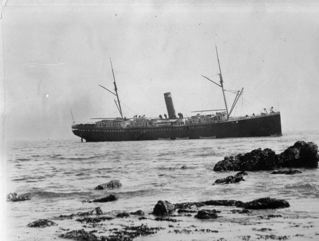
Posted in Colombia, John Vonderlin
Comments Off on 1896: John Vonderlin’s grateful “Colombia Cove” didn’t stick
John Vonderlin Sheds New Light on Gordon’s Chute
Story by John Vonderlin
Email John ([email protected])
Hi June,
The “Chronicling America” website at the Library of Congress is down temporarily, but the California Newspaper Archive is back online. I’ll get back in there soon as we are winding down the “Spring Cleanup” here in Santa Clara with just one more section starting Saturday. I obsessively gather stuff for my building projects, Meg’s wood stove, donations for thrift stores, friends, etc. One site alone contributed 525 “new” bricks which took four loads. My hands are a mess, my backyard looks like a lumberyard and the spare bedroom is piled high with junk I’ll be foisting on any visitors we get. All my “Free is Good” and Packrat tendencies are just about satiated. Sorting, grading, longterm storage, and everything else still needs to be done, but the “JunkLust” is subsiding. I’ll send some pictures of my nuttiness when the piles reach their zenith.
The attached ScreenShots are from the July 15th, 1896 issue of “The Call.” Because the site is down I can’t get the OCR version yet, but when I do I’ll send it along. The accompanying article contains more info on “Gordon’s Chute” then I have seen anywhere else. It also reveals some differences from the generally known history of “The Chute.”
Did you read the HMB Review article about a young man who found “alien” scrawlings on the beach at Tunitas? Apparently, Jim*** is back. Enjoy. John
A PICTURESQUE RUIN
ALL THAT IS LEFT OF ALEXANDER GORDON’S GRAIN CHUTE
One of the first enterprises of any magnitude, outside of mining, ever undertaken in California was the construction of Alexander Gordon’s grain chute on the coast a few miles from Purissima, in San Mateo County. It was done way back in 1860, just after it was demonstrated that the best wheat in the world could be raised on the vast fields of the Santa Clara Valley. It was easy enough to grow the grain, but the trouble was to get it to market. Hauling it by teams to San Francisco was slow and expensive, so Alexander Gordon hit on the idea of his chute, and was not long in getting plenty of backing.
It took several years to build the chute, and it is said to have cost over half a million dollars. When it was finished it was possible for a vessel to lie out in deep water, an eighth of a mile from land, and have the grain poured into her hold from a pipe or come to the deck in sacks as fast as they could be counted.
This was accomplished by building a pier of piles out into the ocean the desired distance, and from the end of an inclined plane, carrying a smooth tube chute which reached to the top of the cliff, 150 feet high, on the shore. The wagons full of grain simply drove to the shore end of the chute and dumped their loads into it. Gravity carried the wheat to the vessel over a quarter of a mile away.
To provide for occasions when there was no vessel to receive the grain, extensive warehouses were constructed on top of the cliff, in which it was store until wanted. There was a little city at the end of the chute and at least 100 men were employed in the different departments and in keeping it in order.
The venture proved a failure on account of the dangerous locality in which it was located. Winds, fogs and treacherous currents sent several vessels that were being loaded ashore. Several men who operated [missing words] the water and were drownded. Loss of life was great and after two seasons the grain chute was abandoned.
No attempt was made to remove any part of it until a few months ago, and it stood there thirty years at the mercy of wind and waves. Not much of the old pier is left standing now, but such as is is most picturesque. The old piles rise grimly from the water and the apron at the end creaks and growns dismally. The actions of the waves has washed out a large portion of the center of the pier so that it would be almost impossible to reach the end now even if one desired to.
The work of removing the old warehouses and other buildings was completed a few weeks ago. All the iron work in the pier that could be reached was taken out. This has, of course, weakened the structure so that it can’t be very long before the waves wash it out of existence.
==========
***Jim Denevan
Posted in Uncategorized
Comments Off on John Vonderlin Sheds New Light on Gordon’s Chute
1894: Henry Cowell Files// “Maria Major Vanishes. With the baby. Was it foul play?” asks John Vonderlin
Story from John Vonderlin
Email John ([email protected])
Hi June,
This is the next chapter in the Cowell/Majors Breach of Contract dispute. It appeared in “The Morning Call,” issue of December 23rd, 1894. Things are not looking good for Antonia. Enjoy. John
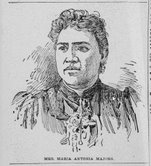
A STRANGE CASE.
Mysterious Disappearance
of Mrs. Majors.
LEFT HOME A MONTH AGO.
And Nothing Has Been Heard of
Her Since.
SHE TOOK HER CHILD WITH HER
Her Relatives Believe She Has Been
Abducted or Foully Dealt
With.
Santa Cruz. Dec. 22.—Relatives of
Mrs. Robert Majors believe she has been
abducted, for she has not been heard from
by them for over a month. She is the
plaintiff in a suit brought about a month
ago for $50.000 for breach of promise
against Harry Cowell, son| of the late
Henry Cowell, a millionaire of San Fran –
cisco.
The suit was originally brought in this
county and subsequently transferred to
the United States Circuit Court, as the de –
fendant is now a resident of Washington,
having left here soon after suit was com –
menced. It was a long time before papers
could be served on him, as plaintiff’s at –
torneys did not know his whereabouts.
One day he paid a flying visit to this city
and then the summons was served.
Mrs. Majors, who is the mother of seven
children, resides near where are Cowell’s
kilns, of which defendant was superin –
tendent. She alleges that defendant had
intimate relations with her on a promise to
marry, and that a child was the result.
Recently Mrs. Majors, who has been re –
siding with relatives here, was visited by
a man named Patterson, who claimed to
be a San Francisco private detective. He
was accompanied by a woman and the
next day after their appearance Mrs.
Majors said he came to look after her pri –
vate affairs. He was not known to any of
her relatives, it is said that she mort –
gaged her place for $5OO and gave the de –
tective $40. When she left with the de –
tective and tbe woman she said that she
was going to San Francisco to prose –
cute her case against Cowell and place the
child in an orphan asylum.
She also promised to write to her rela –
tives, but not a word have they received,
nor have they found any one who has seen
her since she left. They believe that she
has either been abducted or met with foul
play. Mrs. Majors is a woman wbo
weighs probably 200 pounds, of dark com –
plexion and about 35 or 40 years old
Posted in Uncategorized
Comments Off on 1894: Henry Cowell Files// “Maria Major Vanishes. With the baby. Was it foul play?” asks John Vonderlin
Alligator Rock Opens the Door to the South Coast
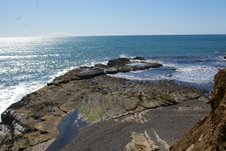

Story/Photos by John Vonderlin
Email John ([email protected])
Hi June,
Here’s a story from the March 2nd, 1902 issue of “The San Francisco Call,” that deals with the treacherous passage around “Cape Horn,” as the spot at Alligator Rock, San Mateo’s southerly coastside entrance, was called. Enjoy. John
P.S. I’ve attached a picture looking down at Alligator Rock and showing about where the stage road would have been. There’s also a picture looking east from the end of the rock showing the remnant of the bluffs they had to get around. Also a picture looking north from the rock showing the view visitors to San Mateo would have first seen. Lastly a photo from the end of the rock catching some spray that almost got us.

SANTA CRUZ, March 1.—The Pescadero
stage had a narrow escape from a disas –
ter yesterday, and that no lives were lost
is remarkable. Twenty miles up the
coast the stage travels along the beach,
which, at high tide, is often covered by
water. Yesterday the ocean was higher
than at any time ln thirty-five years. In
the center of the beach it is very rocky
and rough, with water on either side.
When Driver James Harvey reached this
point a monster wave dashed against the
stage and upturned it.
For two hours the horses, Harvey and
the single passenger, William Steele,
floundered in the cold waters of the Pa –
cific. Fortunately both men were good
swimmers. The horses were cut loose and
found their way to dry land.
Help arrived and after several hours
work the stage was turned over. It was
badly demolished. The vehicle weighed
1600 pounds and was hard to handle. The
top nad been broken off-by the wave, the
iron on the tongue snapped and the dou –
ble-tree ‘broken. The iron rim around the
hub struck the rocks with such terrlflc
force that it was bent as though of tin. ;•
Special Dispatch to The Call.
Wave .Carries Disaster
to the Pescadero
Coach.
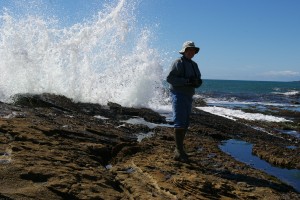
Posted in Uncategorized
Comments Off on Alligator Rock Opens the Door to the South Coast
